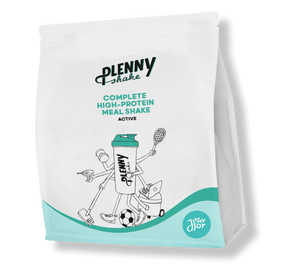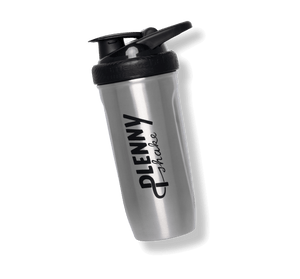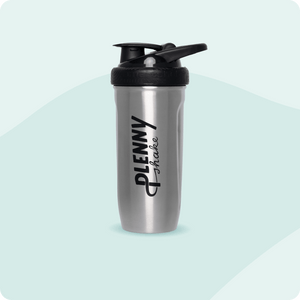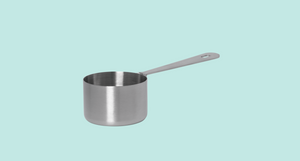
Jimmy Joy and recycling
Sustainability is a key value at Jimmy Joy. That’s why we compensate for CO2 emissions by planting trees, for example. We also provide multiple meals per shipment so there’s less packaging waste and less shipments. Plus: our meals are made of 100% plant-based ingredients! But aside from just reducing packaging waste, we also want to make sure that the packaging itself is as environmentally friendly as possible, and can also be disposed of that way. Let’s break down what we do when it comes to recycling!
Reduce, Reuse and Recycle
First of all, we use the reduce, reuse and recycle principle. To reduce waste, we have the Plenny Shake regular and Plenny Shake Active (XXL) bags. Every bag contains 10 meals, and the Plenny Shake Active contains 25 meals! That’s 9 or 24 less individually packaged meals! Secondly, some of our packaging can be reused as well. Scroll down for some ideas in case you’re down to see Jimmy Joy around your house for a bit longer. And last but not least, our packaging is recyclable: after finishing your Plenny Drink, just flatten the packaging and throw it in the plastic bin. Simple, right?
Our packaging
Plenny Shake and Plenny Shake Active
The bags our Plenny Shakes come in are different from each other. Plenny Shake V3.0 is packaged in a combination of OPP20, PET12 and PE90, while the Plenny Shake Active comes in bags that are made from a combination of PET12 and PE130 plastic. Both versions fall into the plastic recycling category 7 (more about this later) because they consist of mixed plastics. Preferably, we’d only use one type of plastic for the bags since that gets recycled better, but unfortunately that's currently not an option. Mixed plastic ensures that the product inside is well-protected from outside influences such as water, air and light. If exposed, it could influence the shelf life of our meals negatively. A long shelf life is important to us because it prevents food waste! Category 7 still means it can go into the plastic bin and possibly get recycled.
Shaker & Scoop
Our scoops, but also our shakers, are made from polypropylene(PP), which is plastic category 5. We chose PP because it can be injection moulded and because it’s strong for its weight. Despite being lightweight, it can hold a lot. Furthermore, PP is fully recyclable - if you somehow do manage to break your scoop, just discard it in the plastic bin. Maybe next time you pick up a new ice scraper in the store, your old scoop is in it!
Plenny Drinks
The Plenny Drink packaging is made from layered materials: paper/cardboard, aluminium and polymers. Most drink cartons are made from this combination of materials, because every one of these materials is recyclable. Paper can be broken down into fibres and reused in other paper products. It’s done by submerging the packaging in water. By doing so, the layers separate from one another and can be sorted into respective groups to be recycled. The paper used for our drink packages is made from 53% FSC cardboard, though not made with recycled materials. Aluminium is also recyclable and is used in our drink cartons for its protective and preservative qualities: it provides a barrier between the contents of the carton and the light and air on the outside, which can degrade food quality.
As for the plastic in our packaging, the plastic layers, once stripped off, can be recycled the way plastic normally is recycled. The cap of the bottle is made from polypropylene (PP) and polyethylene (PE), and can be discarded with your plastic trash - you can just leave the cap on your Plenny Drink. As for the box the Plenny Drinks come in, this is made from 100% recycled paper and has a 70% FSC-mix label: this one can easily be taken apart, flattened, and can go into the paper trash bin.
Plenny Pots
Just like the Plenny Drink packaging, you can also throw the Plenny Pot containers in the plastic trash, but after taking off the paper wrapper. The pots themselves are made of 100% recycled plastic (100% polypropylene) and are 100% recyclable. The wrappers are made from 100% cardboard and can be discarded in the paper trash. The seals for the pots are made from PET plastic, so can go into the plastic bin as well! On top of everything being recyclable, our packaging also has an Origin Green certification, meaning that it’s part of a sustainability programme which strives to be as sustainable as possible. Origin Green promotes and supports sustainable production processes when it comes to food manufacturing. Yay for being sustainable every step of the way!
Plenny Bars
Our Plenny Bars are individually wrapped, but come in a box that shows them off perfectly. The box is made from 650 micron thick cardboard, which is made from 380GSM virgin fibre boxboard. It has an FSC label, is recyclable, biodegradable and also compostable. As for the inks used on them: they’re all vegetable based!
The wrappers our bars come in are made from OPP20 and GNR20 Matt OPP, which gives them their matte look. OPP means that it’s made from (oriented) polypropylene, which falls under category 5 of the plastic recycling list.
Jimmy Joy Box
Finally, we have the famous turquoise Jimmy Joy cardboard boxes our products come in. They’re made from 100% cardboard and are also completely recyclable! They’re FSC certified and are made from 70% recycled material, and our supplier leads the BELIEVE programme, whose mission it is to be and become as sustainable as possible. Flatten the boxes to put them in your paper bin, or cut them up first to make sure your bin doesn’t fill up as quickly.
Our Starter Guide and Recipe booklet that we send with first orders is also made of recycled paper. This one can go into the paper bin along with the box!
Plans for improvement
As you know, we’re always striving to improve our meals and services. This also means our packaging. Have a look at what we’re cooking up and our future goals:
- We’re currently testing different Plenny Shake (Active) packaging alternatives: recycled plastic, bio-based and biodegradable plastic. We need to test these materials over a longer period of time because it could negatively affect the shelf-life of our meals, which would defeat the sustainability purpose. We aim to switch to one of these options in 2022.
- Up until now, the Plenny Bars have come in a paper box wrapped in plastic. From the next batch on, we’re replacing the plastic with a biodegradable sticker to seal the box.
- For the Plenny Pots, we’re looking into the possibilities of switching from individual pots to a bigger 1kg bag that contains several meals, similar to the Plenny Shake.
- And last but not least, we’re eyeing an even more sustainable version of the Plenny Drink packaging we’re already using. This version has 19% more plant-based material in comparison to the one we’re currently using, and produces 17% less CO2 emission. We’re also looking into larger bottles or bottles made from recycled plastic.
We are constantly on the lookout for ways to upgrade our packaging and reduce our carbon footprint. If you have suggestions or ideas, please submit them on our forum.
But for now…
If you want to reuse our packaging before sending it out for recycling, we’re here to inspire you! Take a look at this post to see how you can reuse a Plenny Drink packaging, or check out this tutorial to see how you can make a bag out of your Plenny Shake bag. Got the starter box left? Or even multiple? Check out this post and this post - we’re sure there’s something for you! Happy recycling!
Recycling outside of Jimmy Joy
Here in the Netherlands, most of us separate our trash. We separate organic waste, plastic, paper, and residual waste, and we can get fined 95 euros if we get caught throwing our waste in the wrong bin [1]! This way of waste disposal was implemented to be kinder to the environment, and to make sure each type of waste is properly disposed of, or gets recycled [2]. So, plastic and paper trash get recycled, but what happens to it exactly? Below, we’ll give you a general idea of how it goes, but the recycling guidelines and processes differ per country, or even per city, so we recommend you to look up your local guides just to be sure about the details.
Save the turtles!
Let’s start with plastic. We’ve all seen those images of the oceans being polluted with plastic waste and turtles stuck in 6-pack rings. In 2010, about 270 million tonnes of plastic was produced, and as far as we could see, about 10,000s to 100,000s tonnes of plastic ended up in the oceans [3]. That’s a lot of plastic!

We try to prevent polluting the environment more by reusing and reducing our waste. By throwing out our plastics into one bin, they can be sent to a recycling centre, essentially reducing the chances of those plastics ending up in the ocean. But some types of plastic are allowed in those bins, and some aren’t… Why?
The types
Plastic comes in all different types, and depending on the type, it gets recycled, incinerated, or discarded. If you’ve ever looked at, for example, an empty Cola bottle, you might have seen the recycling symbol with a number inside of it. This symbol tells you that you can put it in the recycling bin and the number inside of it tells you what kind of plastic it is. These numbers range from 1 to 7. Let’s take a look at all of the different types of plastics that you might or might not have heard of.
1. Polyethylene terephthalate (PET/PETE)
PET is a (usually) clear, strong, lightweight and food grade plastic, mostly used for packaging foods and beverages. The plastic is made of ethylene glycol and terephthalic acid (as the name suggests), which are combined. After they’re combined, they become strands of PET, and after cooling and cutting them into small pellets, these resin pellets are heated until molten, and shaped into whichever shape desired [4]. As mentioned before, PET is mainly used for packaging, such as soda and water bottles, plastic containers, and packaging trays - not only in the food industry, but also in the cosmetic industry [5]. PET can also be used to make mesh fabrics, synthetic fibres, textile (polyester), and is used in the electrical and electronics industry due to its good electrical insulating properties, and in the automotive industry [6, 7].
2. High-density polyethylene (HDPE)
HPDE is a flexible and weather resistant thermoplastic, meaning that it can be shaped with heat and stays in shape after cooling down again. It’s manufactured under low pressure (10-80 bar) and at low temperatures (70-300°C) [8]. It also has a good low temperature resistance. With these properties, HDPE is useful in a lot of industries. It’s used mostly in packaging such as milk bottles and caps, yoghurt tubs and more, but aside from that it’s used in consumer goods, such as trash bags and cutting boards, but also toys. It is also used in fibres and textiles, pipes, wiring and cables, and can be made into sheets [9, 10].
3. Polyvinyl chloride (PVC) or Vinyl (V)
PVC is something you must’ve heard of before – probably in the form of pipes. PVC, just like PET, is a resin which is used in a lot of different products, and there are a lot of forms of PVC: both flexible and rigid kinds. There are more, but we’ll only focus on those two.
Pure PVC is rigid, strong and flame resistant (it can only be moulded at temperatures above 100°C), making it useful in construction, where it’s used for pipes, window and door frames, conduits, and siding of houses [11]. Outside of that, it’s also used in packaging (mainly bottles), curtain rails, audio and videotape cases, credit cards, traffic signs, and a lot more [12].
Flexible PVC is heated and mixed with plasticisers to soften it and make it less rigid, allowing it to be used for other products, such as cling film, shower curtains, garden hoses, bags and tubing for blood transfusions, conveyor belts, toys, and a lot more [11, 12]. Yes, we say “a lot more” a lot. If you’re really interested in the usages of different plastics, we recommend checking out the sources below.
4. Low-density polyethylene (LDPE)
LDPE is a strong, flexible and soft plastic, and manufactured differently from HDPE, as it’s produced at the same temperatures, but at high pressure (between 1000 and 3000 bar) [8]. It’s often used for (food) packaging material such as squeezable bottles (think: ketchup or other sauces); plastic film used to wrap foods such as fruits or meats, frozen food bags, snacks packaging, and dairy products [13]. When not used in packaging, LPDE is used to produce water pipes and hoses for those pipes, flexible toys, wiring and cables, other types of films and housewares. Primarily, however, LPDE is used for plastic (shopping) bags [8], which, by the way, are reusable. Do it.
5. Polypropylene (PP)
PP is a very versatile plastic, found in your kitchen, maybe in your closet, in your car, in the hospital… Yeah, you get it. It’s found in a lot of places in a lot of items. This is because it has a high melting point, is resistant against some common chemicals, is durable, and can be flexible and deformed without breaking [14]. Due to its high melting point, you can find it in your kitchen, in microwave containers, plates, in-house electronics, and in medical applications (because it can be sterilised with steam and alcohol without risking breaking down the plastic) [15]. Aside from that, it can also be found in food packaging, bottles and jars, athletic apparel, area rugs, and toys [16]. Toys benefit from PP because of its durability, and so do our scoops!
6. Polystyrene (PS)
Polystyrene is one of the most common types of plastic, and can be divided into three different PS types: polystyrene, extruded polystyrene foam (XPS), and expanded polystyrene foam (EPS). Polystyrene is a clear, hard, and brittle plastic, often used in plastic cutlery and clear packaging, but can also be used for sturdier items, such as children’s toys (with added colourants), electronics, plant pots, and more [17].
Extruded polystyrene foam is the “original” Styrofoam: the name is a trademark by a company called Dow. This foam is hard and water-resistant, and is often used as building insulation material [18].
The last type of PS is expanded polystyrene foam, which sometimes is also called Styrofoam, though not made by Dow. The name is probably used because it’s a lot easier to remember than expanded polystyrene, which makes sense. EPS is manufactured differently from XPS, giving it a different look and feel. It’s not water-resistant, but has a lot more uses than XPS as it’s softer. It’s often used in food containers, coffee cups, or in cushioning material for packaging. Yes, exactly: those giant blocks consisting of tiny beads that make your hair static, and those edible-looking white Cheetos look-alikes.
7. Miscellaneous
The seventh category is for miscellaneous types of plastics: plastics that don’t fit in any of the previous categories. They usually consist of non-recyclable plastics, or mixed plastic. So no, most plastics that are in this category traditionally don’t get recycled, though in some kerbside collection programs they do get picked up [10]. Examples of items that are made with plastics from this category are safety shields and glasses, headlight lenses, some food containers and bottles. However, there is one type of plastic that we do want to mention in particular: biodegradable plastic. More about this below.
Biodegradable plastic
Biodegradable sounds like a step in the right direction right? A biodegradable plastic means that if it’s left out in the environment, it will degrade over time under the right conditions [19]. Other times the term is used when a plastic is compostable as well. Often, biodegradable plastics get confused with bio-based plastics, which are plastics made out of biological resources (such as Miscan thus Giganteus, also known as elephant grass, extracted sugar from sugarcane or corn, or microorganisms), as opposed to fossil fuel-based resources [20]. Just because a plastic is bio-based doesn’t mean it’s biodegradable, though – and the other way around too: some fossil fuel-based plastics are biodegradable. As of now, the terms are still used interchangeably and cause confusion: there needs to be clearer labelling, according to the European Environment Agency [21], so people know better what to do with the types of plastics. And here’s to add to the confusion: some bioplastics can’t even be composted or biodegraded [19]!
That doesn’t mean they’re useless, though! The bioplastics that can't biodegrade still can be recycled, and this can be done in two ways. The first way is regular recycling, in which the bioplastics are broken down, either by melting or by granulating, and are then reused in other products again. The second way is biowaste: the plastic is composted into biowaste, which then can be used as compost for new crops, or as biogas for renewable energy [22]. Some biodegradable bio-based plastics can even be composted at home, though in most cases, the plastics will only degrade under very specific circumstances. In some cases, where the biobased plastics can’t be recycled or composted, they are incinerated, which recovers energy. So, just because bioplastics end up in category 7 doesn’t mean they’re just all tossed into a landfill, but currently there is a large chance they will.
According to NatureWorks, the manufacturing of bioplastics produces 80% less greenhouse gases than the production of traditional plastics, meaning it is better for the environment [23]. Plus, using bio-based materials means we’re not exhausting the finite source of fossil fuels as quickly. Still, we’re not known for being convinced easily and so we did some more research.
A 2010 study claims that the production of bioplastics might not be less harmful to the environment after all [24]. The production of bioplastics resulted in a greater amount of pollutants, as fertilisers and pesticides are needed for the production of the crops. Also, chemical processing is needed in order to turn the organic material into a usable plastic. So, according to them, the process of manufacturing might be more harmful after all. Interesting findings, right?
So far it seems that the production of bioplastics may have a positive impact on the environment, though. Since this study, more research has been done, and it’s been found by multiple studies that the production of bioplastics has a significant reduction in greenhouse gas emission compared to biofuels [25, 26]. That’s why bioplastics are introduced more and more, mainly in single use items such as cutlery, plates, straws, cups, food packaging and bags, so mainly things that don’t need to be used for a very long time. As of now, bioplastics and biodegradable plastics only make up roughly 1% of all of the plastic production, as the capacity to do so is only as much, but predictions are that by 2025, this percentage will rise to 2.5% [27, 28].
So… Do I need 7 or 8 different plastic bins?
Good news: no! All types of plastic can be put into the plastic bin. In some countries, like in the Netherlands, aluminium, steel or tin cans (whether they’re for soda or for food) also go into this bin. To be completely sure of what and how you can recycle, check your local recycling guide! After your trash gets picked up, it gets sent to a recycling centre, where it gets sorted. No need for you to fill up your home and garden with trash containers if they all get collected on the same day and thrown into the same truck anyway. But… What happens after all of this plastic waste gets picked up by the truck? Let’s find out.
The journey of your plastic cup
What exactly happens to the plastic may differ per country, but we’ll describe the general process to give you an idea of what could happen to the plastic cup you’ve recently thrown out!
After you’ve sorted your plastic, it gets collected and sent off to recycling facilities. Here, the plastics are separated according to their type and sometimes their colour as well. It makes sense to separate them like this: same types of plastics can be put together, and based on what type it is, the next step can be decided. The sorting process has many steps, and is usually done by machines or robots, but in some cases (such as in the US) there are also human workers first who sort out plastics that could jam the machine (think plastic bags or items that won’t fit) before the rest goes into a mechanical sorter [29]. Using magnets, steel or aluminium is sorted out of the plastics, and the plastics themselves are sorted by colour using an optical scanner, and by type of plastic using infrared lasers [29, 30].
Once sorted, the plastic is washed to remove impurities. These impurities could damage the new products, so it’s important to clean the plastics off of these before they get processed further. Impurities can be the glue that’s still on your Coca Cola bottle after you’ve ripped off the wrapper, or food residue that you didn’t clean off before throwing out the packaging.
Immediately after washing, the plastic is shredded or re-melted and resized into smaller pieces: usually into pellets or granules. After this, the plastic gets sorted again, but this time based on their qualities. They’re sorted and collected per quality (such as density, melting points, etc.) and are then sent into the final process of recycling: making something new. This can be done at the same facility, or done at other facilities if they’re better equipped for it.
Due to there being different kinds of plastics, there are also different recycling methods: traditional recycling, and advanced recycling [31].

Traditional recycling
This is also called mechanical recycling sometimes. This method is mainly suitable to recycle thermoplastic materials, meaning PET, PVC and HDPE are probably recycled this way. LDPE, despite being of the same material as HDPE, is harder to recycle, and it is often encouraged to reuse LDPE products instead of putting them out for recycling. This counts for the other two plastic types too: as they’re flimsier, it’s harder to recycle as they might break down in the machinery [32]. They might still get recycled in specialist facilities, but it happens less often.
This method of traditional recycling involves melting the plastics and then processing them into new plastic products.
Advanced recycling
Where traditional recycling mainly focuses on manufacturing a new plastic product, advanced recycling is more suitable for turning plastics into a different product altogether. There are three different techniques when it comes to advanced recycling. The first is with pyrolysis, in which plastic waste is recycled into crude oil. Chemical recycling has it in its name: using chemicals, the plastic is broken down from a polymer into a monomer, and this is then used to create a new product. The third method is gasification, in which plastic is converted to gas, which is used to create energy.
The new products
Every type of plastic could be recycled, so let’s just quickly go through what the different types of plastics can be turned into. We say ‘could be’, because sometimes they aren’t recycled. Sometimes the process takes too long or costs too much compared to producing something from scratch [31]. In other cases, recycling plastic downgrades its quality [33]. Either way, let’s see the possibilities.
PET plastic is usually recycled into fibre and tote bags, furniture and carpets, and bottles and food containers (if pure enough to do so, and not contaminated with anything). HDPE gets recycled into laundry detergent, shampoo and oil bottles, but also into pens, floor tiles, picnic tables and more. Versatile, right?
Number three is PVC, which is often recycled into decks, panelling, flooring, cables, and more, mainly things used in construction. LDPE is a softer and more flexible plastic, and as said before, isn’t recycled as often. If it is, it’s recycled into trash can liners, compost bins, shipping envelopes, panelling and tiles.
PP items are usually recyclable if they’re clean. They get recycled into harder items such as signal lights, brooms and brushes, ice scrapers, bicycle racks, and also into bins, pallets and trays. PS items, usually the ones made from foam, are not recycled because it’s difficult to do so. If PS items are recycled, it’s used for insulation, egg cartons, foam packing and carry-out containers.
The last group of plastics are traditionally not recycled, though if they are used, they go into plastic lumber or custom-made products.

Save the trees!
Yes, we’re on a mission. We’re doing our best to help save both the flora and fauna, and hopefully, after this article, you’re more informed and willing to separate trash properly. Every bit helps!
Surely you can guess where we’re headed with this part: paper. Ever heard of the phrase “reduce, reuse, recycle”? Well, that’s what’s happening with paper. Newspapers have become news-webpages, your monthly bills can now be found online, and now you have no big sheets of paper to put on the floor anymore so your birds keep pooping on the floor and you’re constantly cleaning up after them and… Ah, sorry, that’s just us.
The use of paper has been reduced by a lot over the years, and people are encouraged (sometimes even forced) to receive anything through email instead of the old-fashioned mail. If it really can’t be helped, and you have to receive something that’s made of paper, you’re encouraged to reuse it (such as a paper shopping bag). And if that really doesn’t work, you’re asked to separate that paper trash, so it can be recycled into something new.
Paper has replaced plastic’s functionality in a few industries. As mentioned before, plastic bags have become paper bags, and straws, cotton swabs, and disposable plates have become mostly paper as well. In the EU, most single-use plastics have been banned or will be banned, and these items are being replaced by paper or bamboo alternatives [34].
There’s been a lot of experimenting when it comes to reducing plastic and substituting it with paper, and it also happened in the packaging industry. As you’ve probably already realised, plastic plays a big part in packaging. For food, such as meat, plastic is irreplaceable, since a paper box probably won’t keep your food fresh for too long. But when it comes to ordering stuff online – for example a book – you want it to arrive in a perfect condition with no bent pages. This is where filling comes in: your book needs to have a padding to prevent it from bouncing around in the box so it can arrive in mint condition, and usually, your box will be filled with either these little air bags, or with big sheets of packaging paper angrily crammed into a box by someone fed up with their job. That’s usually what it looks like to us.
Of course, everyone wants to encourage less plastic waste, so the paper alternative gets a loud cheer. But what if we tell you that paper in the packaging industry could be doing more harm than good? As you can imagine, a lot more paper is needed to fill up a box than if you were to use inflatable plastic. According to an American study from 2014 [35], alternatives to plastics in packaging require 4.5 times more material in weight, meaning it’ll cost more energy to ship, and which means it also increases greenhouse emissions, which, you know, contributes to global warming [36].

But if you do get boxes with paper filling, or order a pizza, or don’t really read those newspapers they still put in your mailbox, what should you do with them if you’re not planning on reusing them anyway? Yep, in the trash they go. No, not the regular trash, but the paper trash. Yep, another bin.
Did you know… Pizza boxes do NOT go in there?
Alright, we know we said “order a pizza” and all, but pizza boxes actually do not go in the paper bin. That’s because the paper has been contaminated with oil. Any paper that’s dirty (whether it’s oil, or any other substance that isn’t just regular water) should not go into the recycling bin, as it probably will contaminate the rest of the paper at the recycling plant [37]. Rough, right? We understand you’re trying to do the right thing, but sadly, that paper pizza box has to go in the residual waste bin, unless you can salvage parts of it. If the lid of the box is still clean, you can tear it off and put it in the paper bin, while the bottom part goes into the residual trash.
Other paper products that generally cannot be recycled are products that have a wax, plastic or foil coating, stained paper (such as the pizza box and also paper towels) or paper with paint on it from your kid’s crafting session [38]. If you want to know exactly what you can and cannot recycle, you should probably look up a local guide to be sure!
So… What happens to the paper waste I DO put in?
After your paper waste has been picked up, it gets taken to a recycling centre. First, contaminants are removed to make sure that all there’s left is paper. Then, the paper is sorted by grade and type using STARSCREEN® machines they pass through: these are machines with star-shaped discs that the paper travels over. Any flat and lightweight materials get kicked up and removed through the “top”, while heavier paper falls between the star screens and continues down the line below [39]. The sorted paper is then compressed into bales to be sent to a paper mill. Here, all of the paper is shredded into small pieces, put in water mixed with chemicals, and is then heated. This way, the paper gets broken down into fibres, leaving a slurry or pulp [38, 40, 41]. Depending on what the pulp has to be recycled into, different materials can be added to the mixture to change the end result of the pulp. The pulp is then spread on a wire screen to dry and is then passed through heated rollers so it can dry. After that, it’s rolled up and sent out, now usable to make new paper products!
That’s the general process of it, obviously. Depending on what’s added to the mixture, the recycled paper can be turned into cardboard, egg boxes, napkins and kitchen rolls, paper bags and plates, food cartons, printer and photocopier paper, and a lot more paper products (and even non-paper products) you might be able to come up with [42]. What it gets recycled in usually depends on the quality of the paper: the more often paper is recycled, the shorter the fibres are, and eventually, the fibres are too short to be of strong and high quality [43]. That’s the difference between recycled photocopier paper and newspapers.
SOURCES
[1] Boetes.nl. (n.d.). Niet op voorgeschreven manier aanbieden. Retrieved from https://boetes.nl/boetesoverzicht/milieuvuurwerk/huishoudelijk-afval/niet-op-voorgeschreven-manier-aanbieden
[2] MilieuCentraal. (n.d.). Afval scheiden: nut en fabels. Retrieved from https://www.milieucentraal.nl/minder-afval/afval-scheiden/afval-scheiden-nut-en-fabels/
[3] Jambeck, J.R., Geyer, R., Wilcox, C., Siegler, T.R., Perryman, M., Andrady, A., … Law, K.L. (2015). Plastic waste inputs from land into the ocean. Science, 347(6223), 768–771. https://doi.org/10.1126/science.1260352
[4] PETRA. (n.d.). About PET. Retrieved from http://www.petresin.org/aboutpet.asp
[5] Johnson, T. (April 9, 2018). What Are PET Plastics. Retrieved from https://www.thoughtco.com/what-are-pet-plastics-820361
[6] Britannica. (n.d.-a). Polyethylene terephthalate. Retrieved from https://www.britannica.com/science/polyethylene-terephthalate
[7] Omnexus. (n.d.-a). Polyethylene Terephthalate (PET): A Comprehensive Review. Retrieved from https://omnexus.specialchem.com/selection-guide/polyethylene-terephthalate-pet-plastic
[8] Omnexus. (n.d.-b). Polyethylene (PE). Retrieved from https://omnexus.specialchem.com/selection-guide/polyethylene-plastic#LDPE
[9] AcmePlastics. (n.d.). What is HDPE? Retrieved from https://www.acmeplastics.com/what-is-hdpe
[10] GoodHousekeeping. (March 5, 2021). Exactly What Every Plastic Recycling Symbol Actually Means. Retrieved from https://www.goodhousekeeping.com/home/g804/recycling-symbols-plastics-460321/
[11] Britannica. (n.d.-b). PVC. Retrieved from https://www.britannica.com/science/polyvinyl-chloride
[12] Omnexus. (n.d.-c). Comprehensive Guide on Polyvinyl Chloride (PVC). Retrieved from https://omnexus.specialchem.com/selection-guide/polyvinyl-chloride-pvc-plastic
[13] ICIS. (August 27, 2010). Polyethylene – low density (LPDE) Uses and Market Data. Retrieved from https://www.icis.com/explore/resources/news/2007/11/06/9076157/polyethylene-low-density-ldpe-uses-andmarket-data/
[14] Gutierrez, R.J. (May 21, 2019). What is Polypropylene (PP)? – All You Need to Know. Retrieved from https://all3dp.com/1/polypropylene-pp-all-you-need-to-know/
[15] Omnexus. (n.d.-d). The Definitive Guide to Polypropylene (PP). Retrieved from https://omnexus.specialchem.com/selection-guide/polypropylene-pp-plastic
[16] Plastics, P. (October 29, 2018). What is Polypropylene Plastic? Retrieved from https://www.plasticsmakeitpossible.com/about-plastics/types-of-plastics/professor-plastics-one-of-the-plastics-superheroes-polypropylene/
[17] ChemicalSafetyFacts.org. (n.d.). Polystyrene. Retrieved from https://www.chemicalsafetyfacts.org/polystyrene/
[18] Dow. (n.d.). What is STYROFOAM? Retrieved from https://web.archive.org/web/20080324134328/http://building.dow.com/styrofoam/what.htm
[19] Ceurstemont, S. (May 14, 2020). Bio-based? Recyclable? Biodegradable? Your guide to sustainable plastics. Retrieved from https://www.neste.com/corporate-info/news-inspiration/articles/your-guide-to-sustainable-plastics
[20] Gibbens, S. (November 15, 2018). What you need to know about plant-based plastics. Retrieved from https://www.nationalgeographic.com/environment/article/are-bioplastics-made-from-plants-better-for-environment-ocean-plastic
[21] European Environment Agency. (August 27, 2020). Biodegradable and compostable plastics – challenges and opportunities. Retrieved from https://www.eea.europa.eu/themes/waste/resource-efficiency/biodegradable-and-compostable-plastics-challenges
[22] AllThings.bio. (July 10, 2017). How to dispose of bio-based plastics? Retrieved from https://www.allthings.bio/dispose-bio-based-plastics/
[23] NatureWorks. (n.d.). Why it Matter. Retrieved from https://www.natureworksllc.com/What-is-Ingeo/Why-it-Matters
[24] Tabone, M.D., Cregg, J.J., Beckman, E.J., & Landis, A.E. (September 2, 2010). Sustainability Metrics: Life Cycle Assessment and Green Design in Polymers. Retrieved from http://www.news.pitt.edu/sites/default/files/documents/TaboneLandis_etal.pdf
[25] Bos H.L., Meesters K.P.H., Conijn S.G., Corré W.J., & Patel M.K. (2010). Sustainability aspects of biobased applications, Wageningen Food & Biobased Research report 1166, http://edepot.wur.nl/170079
[26] Bos H.L., Meesters K.P.H., Conijn S.G., Corré W.J., & Patel M.K. (2012). Accounting for the constrained availability of land: a comparison of bio-based ethanol, polyethylene and PLA with respect to non-renewable energy use and land use. BioFBR 6(2), 146-158, DOI 10.1002/bbb.1320, http://onlinelibrary.wiley.com/doi/10.1002/bbb.1320/abstract
[27] PlasticsEurope. (2015). Plastics – the Facts 2015 – An analysis of European plastics production, demand and waste data. Retrieved from http://www.plasticseurope.org/documents/document/20151216062602- plastics_the_facts_2015_final_30pages_14122015.pdf
[28] EMF. (2016). The New Plastics Economy: Rethinking the future of plastics. Retrieved from https://www.ellenmacarthurfoundation.org/publications/the-new-plastics-economy-rethinking-the-future-of-plastics
[29] Peek, K. (August 28, 2013). How It Works: Inside The Machine That Separates Your Recyclables. Retrieved from https://www.popsci.com/technology/article/2013-07/how-it-works-recycling-machines-separate-junk-type/
[30] RecyclingBins.co.uk. (July 31, 2017). How Is Recycling Sorted? Retrieved from https://www.recyclingbins.co.uk/blog/how-is-recycling-sorted
[31] Rinkesh. (n.d.) What is Plastic Recycling? Retrieved from https://www.conserve-energy-future.com/recyclingplastic.php
[32] Tsui, J. (January 16, 2020). Which Plastics Are Recyclable and Which Aren’t? Retrieved from https://eponline.com/Articles/2020/01/16/Which-Plastics-Are-Recyclable-and-Which-Arent.aspx?m=1&Page=2
[33] Sedaghat, L. (April 4, 2018). 7 Things You Didn’t Know About Plastics (and Recycling). Retrieved from https://blog.nationalgeographic.org/2018/04/04/7-things-you-didnt-know-about-plastic-and-recycling/
[34] European Commission. (May 21, 2019). Circular Economy: Commission welcomes Council final adoption of new rules on single-use plastics to reduce marine plastic litter [Press Release]. Retrieved from https://ec.europa.eu/commission/presscorner/detail/en/IP_19_2631
[35] Franklin Associates. (January, 2014). Impact of Plastics Packaging on Life Cycle Energy Consumption & Greenhouse Gas Emissions in the United States and Canada Substitution Analysis. Retrieved from https://plastics.americanchemistry.com/Education-Resources/Publications/Impact-of-Plastics-Packaging.pdf
[36] Helmke, R. (June 3, 2014). Study Notes Benefits of Plastic Packaging. Retrieved from https://www.plasticingenuity.com/blog/study-notes-benefits-of-plastic-packaging
[37] Dean, S. (August 29, 2016). Can pizza boxes actually be recycled? Retrieved from https://www.sbs.com.au/topics/science/earth/article/2016/08/29/can-pizza-boxes-actually-be-recycled
[38] Russell Richardson. (n.d.-a). Is all paper recyclable?. Retrieved from https://www.russellrichardson.co.uk/advice/3/paper-recycling-faqs#paperrecycling3
[39] Recyclingpartnership.org. (May 15, 2019). Recycling - How It Works. Retrieved from https://recyclingpartnership.org/communitiesforrecycling/recycling-how-it-works/
[40] RecyclingGuide.org.uk. (n.d.). How paper is recycled. Retrieved from http://www.recycling-guide.org.uk/science-paper.html
[41] Sukalich, K. (July 1, 2016). Everything You Need To Know About Paper Recycling. Retrieved from https://earth911.com/business-policy/paper-recycling-details-basics/
[42] Russell Richardson. (n.d.-b). What does paper get recycled into? Retrieved from https://www.russellrichardson.co.uk/advice/3/paper-recycling-faqs#paperrecycling4
[43] Russel Richardson. (n.d.-c). How many times can paper be recycled? Retrieved from https://www.russellrichardson.co.uk/advice/3/paper-recycling-faqs#paperrecycling5

 Everything You Need In One Meal
Everything You Need In One Meal
 Stay Full For 3-5 Hours
Stay Full For 3-5 Hours















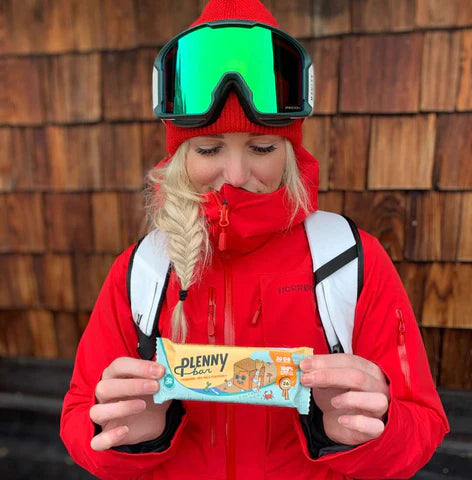





 Product added to cart
Product added to cart




